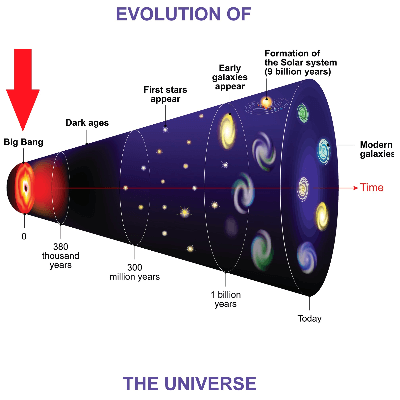
This web page contains Big Bang facts for kids and is a great resource for anyone who wants to learn about the Big Bang theory. We’re going to provide you with the latest and most accurate facts about the Big Bang from scientific sources. Alongside facts about the Big Bang theory and we provide additional resources about it.
The Big Bang facts below will help you understand what the Big Bang theory is, who proposed the Big Bang theory, who coined the term Big Bang, alternative solutions to the Big Bang and other useful facts about the Big Bang. We hope the below facts about the big bang are helpful and open your mind to the evolution of our universe.
If any of the below Big Bang facts are inaccurate or out of date, please contact us and let us know.
13 Big Bang Facts for Kids
- The Big Bang is the prevailing scientific theory about the start and evolution of our observable universe.
- The concept of the Big Bang theory is simple, about 13.8 billion years ago the entire universe started at a single point.
- The theory of the Big Bang was proposed by Georges Lemaitre in 1927. Georges didn’t call it the Big Bang theory, he called it the hypothesis of the primeval atom.
- The term Big Bang was coined by Fred Hoyle, an English Astronomer, during a BBC radio broadcast in 1949.
- Ironically, Fred Hoyle coined the term Big Bang but favored the Steady State Theory and not the concept that the universe starting from a single point.
- In 1929, Edwin Hubble discovered that all the other observable galaxies were moving away from ours. The farther away a galaxy was from the Milk Way, the faster it was moving away from us.
- Edwin Hubble’s observation meant that our universe was still expanding and that at one time all the galaxies in the universe must have been close together.
- Cosmic microwave background radiation was discovered and confirmed in 1965, which then propelled the Big Bang theory as the leading theory of the origin and evolution of our observable universe.
- A common myth is that the Big Bang theory completely explains the origins of the universe. It simply describes the start and evolution of our current universe from a single point.
- The chronology of the universe according to the Big Bang theory has five states, and they are the very early universe, the early universe, dark ages/large-scale structure emergence, the universe as it appears today and the far future.
- Cosmology, a branch of astronomy, is the study of the origin, evolution and fate of our universe.
- A cosmologist is the name of a person who studies cosmology.
- A few examples of alternate theories of the evolution of the universe are the Big Bounce, the Steady State Theory and the Oscillating Universe Theory.
Additional Resources to Research the Big Bang
- What is the Big Bang? – A very basic overview of the Big Bang on the NASA Space Place website.
- What is the Big Bang Theory? – Learn about the Big Bang theory on the Space.com website.
- Big Bang Theory: Evolution of Our Universe – Explore the Big Bang theory and the evolution of our universe on the Universe Today website.
- Big Bang – Wikipedia – Discover more awesome Big Bag facts and information on the Wikipedia website.
